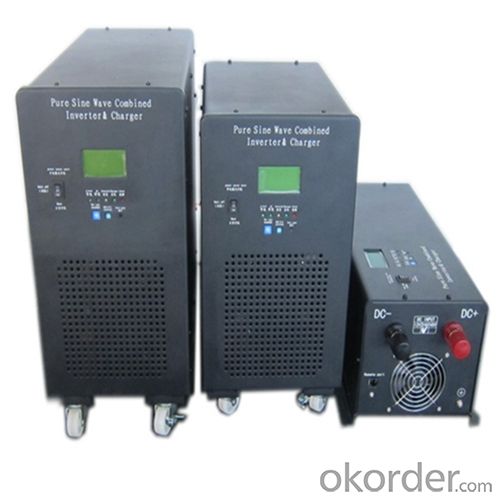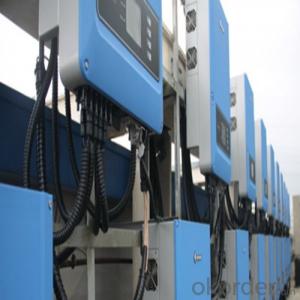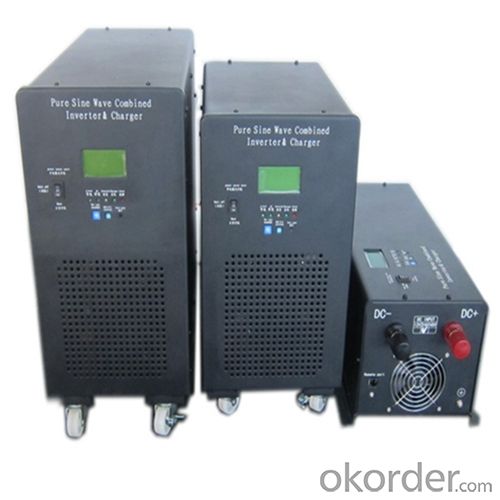Solar Inverter Brisbane - Approved MPPT Solar Charger 3000W 24V
- Loading Port:
- Shanghai
- Payment Terms:
- TT OR LC
- Min Order Qty:
- 5 pc
- Supply Capability:
- 3000 pc/month
OKorder Service Pledge
OKorder Financial Service
You Might Also Like
Performance Characteristics
· 1. Suitable for all electrical equipments
· 2. Large LCD display for more detailed content
· 3. CPU controlled; fast transfer time
· 4. Intelligent battery management, prolonging the service life of the battery
· 5. Complete protection function, high reliability
· 6. Can provide high current charge
· 7. Can match different types of batteries
· 8. Disassembled LCD box which can make the operation in a distance of 15 meters
Product introduction
EP series is sine wave low frequency inverter, which is specifically designed for home appliances. It is equipped with a big LCD screen so all information is displayed in detail, which makes it more convenient to use. Charging current of the inverter is adjustable from 5A to 45A and you can also select different charging voltage to charge different types of batteries so batteries are under great protection.
Our Service
Samples
Samples are Available for Testing and Market Test.
Warranty
We provides warranty against defects in materials and workmanship for its Uninterruptible power supply, Power inverter/chargers including inverter12v 24v 48V, Solar charge controllers (“Product”).
OEM Service
OEM service is strictly based on the ISO9001 ISO14001 quality assurance system. The TOP involves the effective teamwork of departments from Sales, R&D, and Engineering, purchasing, production & QA, assuring a high quality product and prompt delivery for customers. The standardization of our quality system and the quality stability has earned us the trust of our customers for 12 years.
We have 10 sets of automatic insertion equipments, ICT PCB testing equipments, ATE automatic testing center and aging workshop for all products. Monthly output of UPS series exceeds 200,000. We have been offering OEM service for over 12 years.





Specifications
Input | |
Input Voltage Range | 182-265VAC |
Output | |
Input Voltage Range | Batt.Mode:50±0.3Hz Mode:48-54Hz(50Hz) or 58-64Hz,Same as AC |
Output Wave Form | Sine Wave (Batt,mode) |
Transfer Time | 10ms(Typical) |
FAQ:
Q: Do you have the CE, TUV, UL Certification?
A: We’ve already passed all the tests, and any certificate is available.
Q: Have you ever sold your products to companies in my country?
A: Of course, we have customers in all general PV markets, but I think we should expand our market share along with the market growth.
Q: When did your company set up? You are a new company, how can I believe your quality?
A: We entered into Solar PV industry in 2005, now we have several plants in manufacturing of a-Si and c-Si panels, and our capacity is 220MW per year. Till now we have already passed all the tests by authorized laboratories, e.g. TUV, CE, UL.
Q: Can you help us install the module if we cooperate with you?
A: We haven’t entered into installation sector, but we have the plan in near future.
Q: How do you pack your products?
A: We have rich experience on how to pack the panels to make sure the safety on shipment when it arrives at the destination.
Q: Can you do OEM for us?
A: Yes, we can.
Q: Can we visit your factory?
A: Surely, I will arrange the trip basing on your business schedule.
- Q: Can a solar inverter be used with solar trackers?
- Yes, a solar inverter can be used with solar trackers. Solar trackers are used to maximize the efficiency of solar panels by orienting them towards the sun. Solar inverters are responsible for converting the DC power generated by solar panels into usable AC power. Both components work together to optimize solar energy production.
- Q: What is the role of a solar inverter in maximizing solar panel output?
- The role of a solar inverter in maximizing solar panel output is to convert the direct current (DC) generated by the solar panels into alternating current (AC) which can be used to power electrical devices in homes or businesses. The inverter ensures that the AC output is synchronized with the grid's frequency and voltage, allowing for efficient and effective utilization of solar energy. Additionally, the inverter also helps in monitoring and optimizing the performance of the solar panels, ensuring that they operate at their maximum efficiency and produce the highest possible output.
- Q: Can a solar inverter be used in harsh environmental conditions?
- A solar inverter is capable of operating in harsh environmental conditions. It can withstand a wide range of environmental factors, including extreme temperatures, humidity, dust, and vibrations. Manufacturers often construct solar inverters using durable materials and apply protective coatings to shield them from severe weather conditions. Furthermore, many solar inverters are equipped with advanced cooling mechanisms to prevent overheating in hot climates. Nevertheless, it is crucial to consider that the durability and performance of a solar inverter in harsh conditions may differ depending on the brand and model. To guarantee optimal performance and longevity, it is advised to select a reliable and high-quality solar inverter specifically designed for use in harsh environmental conditions.
- Q: What is the maximum AC current output of a solar inverter?
- The maximum AC current output of a solar inverter varies depending on the model and capacity of the inverter. Generally, it can range from a few amps to several hundred amps.
- Q: Grid-connected inverter is generally divided into photovoltaic power generation grid-connected inverter, wind power grid-connected inverter, power equipment and grid-connected inverter and other power generation equipment power generation inverter.
- The grid inverter is a current source, the output voltage is basically the grid voltage, may be slightly raised.
- Q: The working principle of photovoltaic grid - connected inverter
- Full-bridge inverter circuit to overcome the shortcomings of the push-pull circuit, the power transistor to adjust the output pulse width, the output AC voltage RMS that changes. Since the circuit has a freewheeling circuit, even if the inductive load, the output voltage waveform will not be distorted. The disadvantage of this circuit is that the upper and lower arms of the power transistor are not common, so you must use a special drive circuit or use isolated power supply. In addition, in order to prevent the upper and lower arm co-conduction, must be designed to turn off after the conduction circuit, that must be set dead time, the circuit structure is more complex.
- Q: Can a solar inverter be used in areas with high seismic activity?
- Yes, a solar inverter can be used in areas with high seismic activity. However, it is essential to ensure that the solar inverter is designed to withstand seismic vibrations and has been installed using appropriate seismic-resistant mounting techniques. Special precautions and engineering considerations may be necessary to ensure the inverter's integrity and functionality during seismic events.
- Q: Can a solar inverter be used with a solar-powered water purification system?
- Yes, a solar inverter can be used with a solar-powered water purification system. A solar inverter is responsible for converting the direct current (DC) electricity produced by solar panels into alternating current (AC) electricity that can be used to power various appliances and systems. In the case of a solar-powered water purification system, the solar inverter would be essential in converting the DC electricity generated by the solar panels into the appropriate AC power required to operate the system's pumps, filters, and other components.
- Q: What are the typical efficiency ranges for different types of solar inverters?
- The typical efficiency ranges for different types of solar inverters vary depending on the specific technology and design. However, in general, string inverters have an efficiency range of around 95% to 98%, while microinverters tend to have an efficiency range of about 96% to 99%. On the other hand, central inverters have a wider efficiency range, typically ranging from 95% to 99%. It's important to note that these efficiency ranges can also be influenced by factors such as temperature, load, and design variations among manufacturers.
- Q: Generally a large grid-connected photovoltaic power plant will have several inverters
- Group is the use of a number of grid-connected inverter and grid-connected AC power grid, the advantage is the loss of small, low cost of the cable (because the PV cable is more expensive), eliminating the cost of the convergence box, and multiple
Send your message to us
Solar Inverter Brisbane - Approved MPPT Solar Charger 3000W 24V
- Loading Port:
- Shanghai
- Payment Terms:
- TT OR LC
- Min Order Qty:
- 5 pc
- Supply Capability:
- 3000 pc/month
OKorder Service Pledge
OKorder Financial Service
Similar products
Hot products
Hot Searches
Related keywords



























